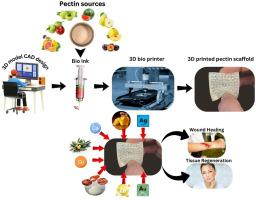Pectin based three dimensional printing in wound healing: Innovations, challenges, and future prospects: A review
IF 6.5
Q1 CHEMISTRY, APPLIED
Carbohydrate Polymer Technologies and Applications
Pub Date : 2025-08-11
DOI:10.1016/j.carpta.2025.100976
引用次数: 0
Abstract
Pectin is a complex polysaccharide and a structural fiber found in plant cell walls, particularly in the primary cell wall and middle lamella. In recent decades, pectin, a biopolymer derived from citrus fruits, apples, and sunflower heads, has drawn remarkable attention as a promising biomaterial due to its biocompatibility, biodegradability, anti-inflammatory and anti-bacterial properties. Wound healing is a dynamic and complex process essential for restoring the integrity and function of tissues. The convergence of natural polymers with wound healing properties and cutting-edge printing technologies has resulted in the development of personalized wound dressings for wound management and regenerative medicine. The versatility of pectin as a biomaterial has led to its incorporation in various wound healing applications, including hydrogels, films, and scaffolds. 3D printing technology offers precise control over the architecture and composition of these pectin-based structures, allowing for the creation of tailored wound dressings that can address specific healing requirements. These advanced dressings can potentially enhance wound healing by providing a moist environment, promoting cell proliferation, and delivering therapeutic agents directly to the wound site. This comprehensive review delves into the nuances of three dimensional (3D) printing technology, along with the applications of pectin-based 3D printed dressings in wound healing and tissue regeneration.

基于果胶的三维打印在伤口愈合中的应用:创新、挑战和未来展望
果胶是一种复杂的多糖和结构纤维,存在于植物细胞壁中,主要存在于原代细胞壁和中间片层中。近几十年来,果胶作为一种从柑橘类水果、苹果和葵花籽中提取的生物聚合物,因其生物相容性、生物可降解性、抗炎和抗菌特性而备受关注。伤口愈合是一个动态和复杂的过程,对恢复组织的完整性和功能至关重要。具有伤口愈合特性的天然聚合物和尖端打印技术的融合导致了用于伤口管理和再生医学的个性化伤口敷料的发展。果胶作为一种生物材料的多功能性使其在各种伤口愈合应用中得到应用,包括水凝胶、薄膜和支架。3D打印技术提供了对这些基于果胶的结构的结构和组成的精确控制,允许创建定制的伤口敷料,可以满足特定的愈合要求。这些先进的敷料可以提供湿润的环境,促进细胞增殖,并将治疗剂直接输送到伤口部位,从而潜在地促进伤口愈合。这篇全面的综述深入探讨了三维(3D)打印技术的细微差别,以及基于果胶的3D打印敷料在伤口愈合和组织再生中的应用。
本文章由计算机程序翻译,如有差异,请以英文原文为准。
求助全文
约1分钟内获得全文
求助全文

 求助内容:
求助内容: 应助结果提醒方式:
应助结果提醒方式:


